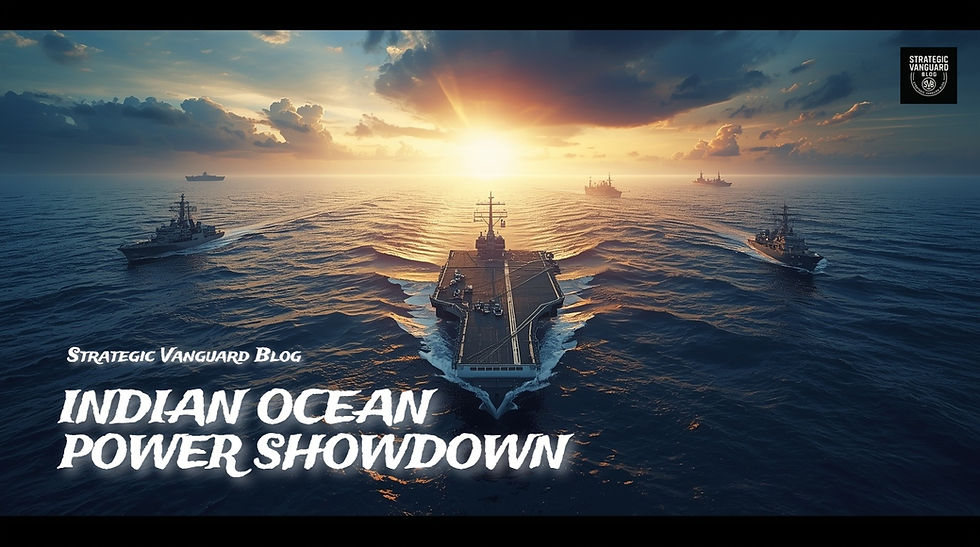Asia-Pacific Power Game 2025: India, China, USA, Japan & Russia in the New Global Order
- Manoj Ambat

- Jul 25
- 4 min read

As we navigate the second quarter of the 21st century, a silent yet significant power game is unfolding—one that will define not just the future of Asia-Pacific, but the trajectory of global geopolitics. At the heart of this emerging strategic confluence are five pivotal players: India, China, Japan, the United States, and Russia.
JAPAN: The Resurgent Samurai
Japan has long been one of Asia’s technological and economic giants. Following its pacifist stance post-World War II, Japan focused on becoming an economic superpower under American security guarantees. However, the rise of regional tensions and the assertiveness of China and North Korea have pushed Tokyo to recalibrate its defense posture.
Today, Japan is steadily emerging from its self-imposed military constraints. With the reinterpretation of its pacifist constitution and increasing defense spending (crossing the 2% of GDP mark), Japan is investing in next-gen missiles, cyber capabilities, and counter-strike systems. It has also unveiled plans for its own next-generation fighter jet program in collaboration with the UK and Italy. As part of the Quad and with growing strategic alignment with India, Japan is poised to be a central pillar in Asia’s evolving security architecture.
CHINA: Assertive and Ambitious
China is now firmly established as the world’s second-largest economy and Asia’s foremost military power in terms of capability and reach. With rapid advancements in AI, hypersonic weapons, aircraft carriers, and space capabilities—including a permanent space station—China's military modernization is moving at a historic pace.
Beijing's foreign policy is increasingly assertive, backed by the Belt and Road Initiative, String of Pearls strategy, and aggressive posturing in the South China Sea, Taiwan Strait, and the Himalayan border with India. The Chinese Communist Party under Xi Jinping has made it clear that its goal is to reshape the global order to suit Chinese interests.
INDIA: The Balancer of Asia
India has emerged as a major geopolitical force with a rapidly expanding economy (now the fifth-largest in the world) and a robust military modernization drive. India has become a leader in space technology, cyber defense, and is strengthening all three wings of its armed forces.
The Indian Navy is now a key player in the Indo-Pacific with INS Vikrant, the indigenous aircraft carrier, already commissioned. India is also enhancing submarine capabilities (including SSBNs), inducting 5th-generation fighter jets, developing hypersonic missiles, and reinforcing its nuclear triad. As a founding member of the Quad, India is forging stronger strategic ties with the US, Japan, Australia, and Vietnam, positioning itself as the regional counterweight to China.
However, India must continue to deepen its influence in South and Southeast Asia by building partnerships, enhancing defense cooperation, and investing in regional connectivity projects to offset China’s strategic encirclement.
UNITED STATES: The Pacific Stabilizer
Despite growing multipolarity, the United States remains the global power with the widest reach. Although challenges at home and emerging powers abroad have led some to question American primacy, the US continues to be the great equalizer in the Indo-Pacific.
With forward-deployed assets in Guam, Japan, South Korea, and the Philippines, and strengthened ties via AUKUS, the Quad, and the newly revitalized US-India defense partnership, Washington is committed to deterring Chinese aggression and preserving the rules-based international order. Its Indo-Pacific Strategy is clear: America is here to stay.
RUSSIA: The Unpredictable Power
After its full-scale invasion of Ukraine in 2022, Russia’s global standing has shifted. Isolated from the West, Moscow has turned to Asia to expand its influence. While its economy remains under strain from sanctions, Russia maintains a strong military-industrial base and nuclear arsenal.
Russia has intensified defense cooperation with China, Iran, North Korea, and occasionally even India. However, its role in Asia is increasingly that of a strategic balancer and arms supplier rather than a direct regional hegemon.
AN OVERVIEW: The Asia of Tomorrow
The 21st-century power matrix in Asia will be shaped largely by the triangular dynamics between India, China, and the United States, with Japan and Russia acting as strategic pivots.
China remains the dominant power, but its aggressive posture has united several regional and global powers in counterbalance. India, with its demographic dividend, strategic geography, and democratic model, is emerging as the critical balancer in the region.
China’s “String of Pearls” remains a concern for India, with Beijing deepening ties with Pakistan, Sri Lanka, Myanmar, and Bangladesh. India’s efforts to counter this include a Look East–Act East policy, strategic investments in Chabahar Port (Iran), and defense diplomacy with ASEAN nations.
THE ROAD AHEAD FOR INDIA
It is imperative for India to:
Strengthen alliances with Japan, Australia, Vietnam, and the US
Expand its defense industrial base under Atmanirbhar Bharat
Enhance maritime capabilities in the Indian Ocean
Increase its influence in the Global South and African nations
Deter Chinese aggression through diplomatic strength and military readiness
India must also shape the regional discourse by being not just a regional power but a norm-setting global voice.
A STRATEGIC CONFLUENCE IN ASIA
A new balance of power is emerging. The Indo-Pacific will be the epicenter of 21st-century geopolitics, and India must lead with confidence, clarity, and conviction. While rivalry with China is inevitable, a cold war must be avoided. Strategic competition should be tempered by diplomacy, deterrence, and dialogue.
This is India's moment. It is time to show the world that India is not just rising—it has arrived.



Comments